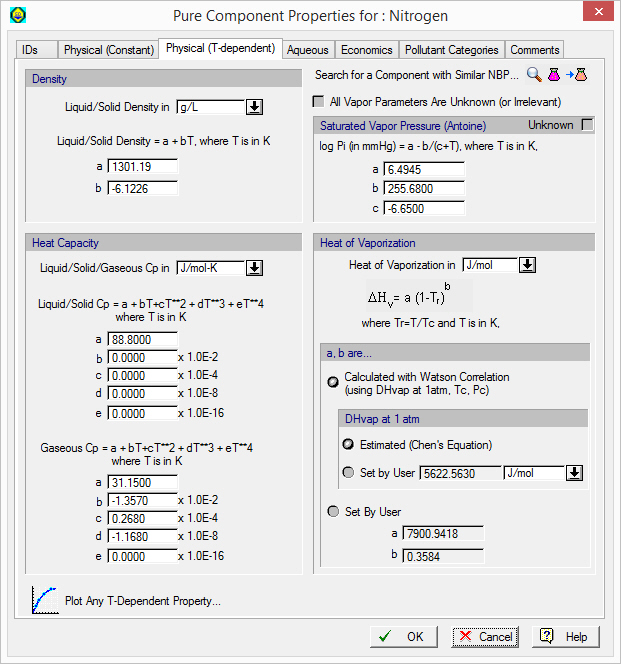

This tab is part of the Pure Component Properties Dialog and it is shown in the following cases:
● when you display the properties of a registered pure component as part of the Pure Component Registration Dialog, which is either new or copied from the component databank for a pure component that originated from the ‘Designer’ or ‘User DB’ (not DIPPR or PPDS), or
● when you display the properties of a pure component in the component databank and as part of the Pure Components Databank Dialog, for a pure component that originated from the ‘Designer’ or ‘User DB’ (not DIPPR or PPDS)
Used in converting between mass and volumetric flowrates, and calculating the concentration of species in streams. For SuperPro Designer-formatted components, the density correlation is assumed to apply for either the liquid or the solid phase (whichever applicable). If the system needs the density of a component in a vapor phase (i.e., at a temperature T that is higher than its normal boiling point) the system uses the ideal gas law or a user-selected equation of state to estimate the molar volume; then the density is taken as the inverse of the molar volume at that temperature (T).
Used in energy balances. It is based on the formula:
|
|
eq. (3.1) |
Used in energy balances. It is estimated based on the formula:
|
|
eq. (3.2) |
Used in flash drum and condenser. It is based on Antoine’s Equation:
|
|
eq. (3.3) |
Used in energy balances in flash evaporation and condensation. It is calculated using the Watson’s correlation equation:
|
|
eq. (3.4) |
where Tr = T/Tc and Tc the critical temperature in K.
The user can either choose to provide the values of the correlation parameters a and b or those parameters can be calculated from a combination of the Chen method for estimating the heat of vaporization at normal boiling point and of the Watson empirical formula for capturing the dependence on temperature (see ‘The Properties of Gases and Liquids’ by R.C. Reid, J.M. Prausnitz and B.E. Poling for details). The fundamental properties needed in these empirical formulas are the normal boiling point and the critical temperature and pressure.
|
|
There is a single equation for every property for SuperPro Designer formatted components. DIPPR, on the other hand, offers up to 8 different equations (correlations) as shown in the DIPPR Pure Component Properties Dialog: Physical (T-dependent) tab. |
Finally you may plot any temperature dependent property by clicking on the Plot Any T-Dependent Property button and selecting the temperature range and increment on the T-Dependent Property Graph Dialog that appears.
Checking the “Vapor Pressure Parameters Are Unknown” check box on this tab will make all vapor pressure estimation parameters (Antoine coefficients in this case) zero, and signify that the component cannot be used in VLE thermodynamic calculations in the process that engage Raoult’s or Modified Raoult’s Law or the Gamma-Phi model. If this component is present in contents that are flashed rigorously, it must added to the set “excluded from VLE calculations”. For more information please See also The Rigorous Physical State Calculation Toolbox
|
|
It is highly advised to check the Vapor Pressure Parameters Are Unknown flag, if you do not know or are unsure of the validity of the vapor pressure estimation parameters of a pure component. This will avoid any inappropriate calculations of thermodynamic properties. |
For more information on this subject see also, Vapor Pressure Parameters Are Unknown Option.
Typically when introducing a new pure component in a process model, users will select an existing component (from the list of already registered components or from the list included in the Designer or User DB) as a ‘mold’ (see ). The newly created component then will have all the physical properties of the original ‘mold’. Then, users will typically proceed to modify the properties of the new component to match its real properties. Users are urged to at least modify the:
- The Molecular Weight (esp. if mol fractions or mol concentrations are needed), and
- The Normal Boiling Point (NBP) since by default, the shortcut criterion based on the NBP will be used to determine if this component is vapor or liquid/solid in a mixture with other components in a stream or as part of the vessel contents.
The rest of the component’s physical properties may not be known. However, changing the NBP and keeping the mold’s components vapor pressure parameters (Antoine) will lead to a conflict, and SuperPro will not allow to register this component. If you don’t care to have this component engage its Antoine coefficients at all (so you will never select it as part of the emitted set on a Vent/Emissions tab) or you don’t really want to use the Antoine shortcut criterion as the V/L determining criterion for the state of the component, then you can simply choose Vapor Pressure Params ‘Unknown’ (see above). However, if you do wish to keep the component as part of your emitted set, then you will be forced to find a new set of Antoine coefficients that will match your ‘estimated’ (or from literature) normal boiling point. That’s when clicking this button: (Search for a Component with Similar Props...)
(Search for a Component with Similar Props...)
will come very handy.
When you do, the Search for a Component with Similar NBP... Dialog will appear that will help you choose a component that has a similar normal boiling point, and from that component you can ‘steal’ its properties so that they are consistent and acceptable to SuperPro.
For more details on each property, see Pure Component: Temperature-Dependent Physical Properties.